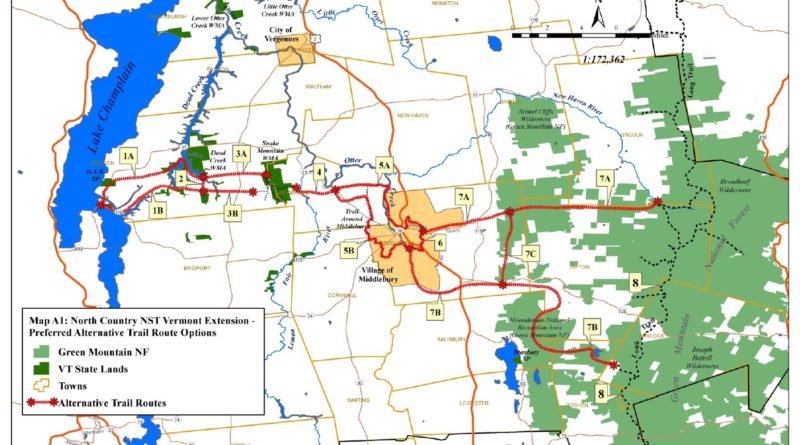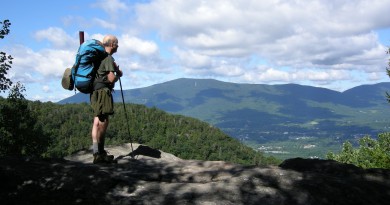This New Trail Takes Hikers Coast to Coast—Via Vermont
Imagine hiking from Maine to Oregon, via Vermont via major trails. Thanks to recent legislation, the missing link—just 13 to 16 miles in Addison County—is a step closer to becoming a reality.
By Andy Kirkaldy
If you’ve ever dreamed of a trail that would have you hiking from sea to shining sea, Maine to Oregon (via Vermont, of course), take heart.
On February 12, the U.S. Senate passed the Natural Resources Management Act by a 92-8 vote. Just two weeks later, the House of Representatives approved it 362-62, sending it to the president’s desk for signing. The comprehensive public lands bill permanently reauthorizes the Land and Water Conservation Fund.
And it includes a provision to link the North Country National Scenic Trail with the Long Trail and Vermont sections of the Appalachian Trails, by way of a new trail system in Addison County.
The Lewis and Clark Trail starts in Seaside, Ore. and stretches east, connecting to the North Country Trail in North Dakota. That trail runs through the Midwest and New York’s Adirondacks until it reaches its current terminus, the Champlain Bridge in Crown Point, N.Y.
Under the proposed plan, the North Country Trail, projected to be 3,200 miles long, would pass through Addison County. There, it would intersect with the Long Trail, which in turn intersects with the Appalachian Trail at Willard Gap, just north of Route 4.
The missing link lies between the Long Trail in Addison County and the Champlain Bridge. That stretch (which the National Park Service estimates at 40 miles of trail), was originally contemplated as part of the North Country Trail but the Green Mountain Club objected to it in the 1970s. The club feared the link would lead to overuse and damage to the Long Trail, which the club manages. As a result, the linking stretch was not included in the 1980 authorization.
Vermont Rep. Peter Welch (D) helped introduce the legislation on the proposed trail extension.
Senator Leahy’s aide Lincoln Peek said this bill is a vital first step, but cautions that much remains to be done, including finding funding, acquiring land rights and developing local partnerships. It could be a decade before the trail is a reality. But he also said the bill is a vital “first step.”
“The passage of this authorization in the Senate is a real victory. The Vermont connection is literally the missing link,” Peek said.
“Finalizing the trail location and getting it built will take time and resources, and Senator Leahy, through his work on the Senate Appropriations Committee, is already working to secure funding for this important project. He and his staff will also work to see that the National Park Service and the U.S. Forest Service are full partners with the local organizations and property owners who will be critical to building this trail.”
Leahy himself said reauthorizing the Land and Water Conservation Fund was another vital component of the bill. The fund, which draws on land leases and extraction rights given to fossil fuel companies, provides grants and other help for natural resource projects.
The exact route is yet to be determined, but what a National Park Service document provided by Leahy’s office calls the “preferred corridor” runs from the Lake Champlain Bridge through West Addison farmland, the Dead Creek Wildlife Management Area, Addison village, up and down (or possibly around) Snake Mountain and on to the Trail Around Middlebury. There the corridor offers two alternative routes, both reaching existing trails in the Green Mountain National Forest.
The National Park Service (NPS) plan estimates that about 13 to 19 miles of new trail would need to be built, with the rest relying on existing trails. The route choices depend in part “on which landowners are willing to cooperate in establishing the trail.”
The document states the NPS cannot obtain land by eminent domain for trail projects, but can purchase land or easements.
Cost estimates are not precise. The NPS document foresaw the 13 to 19 miles of new trail “potentially requiring an estimated $450,000 to $6 million in land acquisition costs.”
The NPS document also claims benefits for property owners and neighbors: “Landowners may also see increased (or more stable) property resale values due to proximity to permanently protected open space.”
It also hoped for a boost for local businesses from “increased visitation and associated economic activity.”
The document describes a low-impact trail intended primarily for hiking that would allow other “compatible recreational activities such as snowshoeing, bird watching and nature study,” while noting, “The trail’s authorizing legislation prohibits motorized use.”
Featured Photo Caption: Above are the proposed paths for the 40-mile connector trail that would link the 3,200-mile North Country Scenic Trail with the Appalachian Trail via Vermont’s Long Trail. As proposed, the connector would follow the Trail Around Middlebury and head through the Moosalamoo National Rec. Area. Photo by the National Park Service


